Metro’s Joint Policy Advisory Committee on Transportation (JPACT) met this morning to set policy parameters on how to allocate $20-24 million in federal Metropolitan Transportation Improvement Plan dollars (MTIP) — also known as Regional Flexible Funds. After some tense discussion, the committee split 7-6 in favor of a motion to target 75% of the funds for active transportation projects and 25% for freight projects (after that contentious amendment passed, the committee unanimously passed the full resolution).
“No one wants this to be about bikes versus trucks… It shouldn’t be a debate, but unfortunately we have very little money to distribute so it ends up sounding like that.”
— Carlotta Collete, JPACT Chair
At the outset of the meeting, Chair Carlotta Collette tried to defuse what she knew would be a tense agenda item, urging the audience and JPACT members to not see this as a battle between bikes and trucks. “No one wants this to be about bikes versus trucks… It shouldn’t be a debate,” she said, “but unfortunately we have very little money to distribute so it ends up sounding like that.”
Collette emphasized repeatedly that this decision was just for spending in 2014-15. “This is not a lifelong commitment to spending our money this way.” Yet, despite her hopes, the discussion — and the vote — ended up coming down to bikes vs. freight.
Bill Wyatt, the executive director of the Port of Portland, began the discussion by amending his previous proposal to put 25% into the “Active Transportation/Complete Streets” project category and 75% in the “Green Economy/Freight Initiatives” category (that’s the proposal that mobilized bike advocates and sparked the debate). Wyatt then amended his own motion and put dollar amounts of $11 million for freight and $12 million for active transportation (about a 45/55 split).
Metro Councilor and JPACT member Kathryn Harrington was next to speak. Saying that “Metro is much more comfortable with a different split,” she put forward a counter amendment and proposed 75% for active transportation and 25% for freight (flipping Wyatt’s initial motion). A discussion followed.
Wyatt reminded the committee that freight was shut out of the last Flexible Fund allocation and also referred to a grim future funding picture for freight-friendly road modernization projects (ODOT’s Region 1 director Jason Tell shared at the outset of the meeting that there’s no budget for matching funds, key to leveraging big federal dollars). Wyatt opposed the motion put forward by Metro’s Harrington, saying, “Meager and pathetically small as this pile [of money] is, it’s a more important pool of resources today that it might have previously been.”
Washington County Commissioner Roy Rogers also opposed the motion on grounds that the region needs to do more to support businesses and the economy (which in this meeting came to be synonymous with freight). “Outside this room, there’s a recession going on… Frankly, if we want to keep this economy going… foreclosures are on the rise, we’re losing jobs, outside this room folks are having a difficult time… Anything that helps the business community we have to take a hard look at.”
“… The argument that there’s no other source of money [for active transportation] has really turned on its head.”
— Jason Tell, ODOT Region 1 Director
ODOT Region 1 Director Jason Tell rebutted the argument by active transportation advocates that this pot of money is crucial to biking and walking projects. “At one time that was true,” he said. To make his case, Tell said that since 2000 the money available for biking and walking projects is going to grow by 500%. On the other hand, with MTIP Flexible Funds set to only grow 50% in that same time period and with regional modernization budgets going to zero, he claimed that, “the argument that there’s no other source of money [for bike/ped] has really turned on its head.”
Speaking up for biking and walking projects, Metro Councilor Rex Burkholder disagreed with Tell’s analysis. “If you look at the large regional picture, we have a need for sidewalk and bikeways, this is one of the few areas we’re able to direct dollars to them… There are a lot of funds available for freight.”
City Commissioner Nick Fish, speaking as an alternate JPACT member in place of Portland Mayor Sam Adams, echoed Burkholder and said that while they understand that moving freight is a “key piece” of the regional transportation picture, “there are substantial pots of funding.. to address freight needs.” He then pointed out the stats we shared yesterday: From 1995-2010 the region has invested $4.2 Billion in roads, bridges and freight while investing a mere $153 million in biking and walking projects (and of that, 30% came from this MTIP pot).
Fish said, “When we invest in trails, there’s a huge return to the public.” He also expressed concern that any targets below 75/25 in favor of biking and walking would set a bad precedent. “We don’t think it’s time to back off that commitment.”
Steve Stuart, a Clark County Commissioner, offered memorable testimony in favor of the pro-biking and walking Metro motion. Stuart offered perspective, saying that “we’re fighting over budget dust” and that an impending Oregon request for the Columbia River Crossing project will be “$400 million for one freight project.”
Stuart added, “I prefer to support projects over process… The freight projects you can accomplish for this amount of money are things like ‘preparation’, ‘regional strategies’ and ‘freight development’ — these are processes you’d be paying for. You’re not going to get projects on the ground for that kind of money.” And for the politicians in the room, he offered this: “There’s no ribbon cutting for processes.”
Stuart said he recognizes the need for freight projects, but would rather fight for them in the big leagues of transportation funding, like through the legislature in Salem and on Capitol Hill.
When it came time to vote on the 75/25 active transportation/freight funding target, it was very close. 7 members were in favor, 6 were opposed, and 3 abstained. Here’s how the votes went:
YES
– Jack Burkman, Vancouver City Council Member
– Kathryn Harrington, Metro Councilor
– Rex Burkholder, Metro Councilor
– Neil McFarlane, TriMet GM
– Steve Stuart, Clark County Commissioner
– Nick Fish, Portland City Commissioner
– Deborah Kafoury, Multnomah County Commissioner
NO
– Bill Wyatt, Port of Portland – NO
– Craig Dirksen, Mayor of Tigard
– Jason Tell, ODOT Region 1 Director
– Roy Rogers, Washington County Commissioner
– Ann Lininger, Clackamas County Commissioner (“We absolutely support active transportation, but we are committed to support our businesses through this recession.” — Her No vote is interesting because she was representing fellow commissioner Lynn Peterson, one of the most staunch active transportation supporters in the region)
– Shirley Craddick, Gresham City Councilor
Now official, JPACT Chair Collette said the 75/25 funding allocation will not act as a hard and fast project spending split. From here, a single task force made up of freight and biking/walking advocates will sit down in the same room and try to agree on a project funding list. The 75/25 was referred to as merely “gentle guidance” for that group. (Interesting to note that initial plans were for separate bike/freight task forces to be assembled, but Chair Collette passed a motion to combine them into one.)
Another interesting note about this morning’s meeting was a motion that passed to set aside $500,000 “off the top” (a.k.a. an earmark) of these funds for an electric vehicle industry development project in Clackamas County. The motion was put forward by Commissioner Ann Lininger. Rex Burkholder was the sole vote in opposition. He seemed to be more perturbed by the nature of the motion more than the project itself. Given the bloody funding battles we’ve all become used to in the active transportation world, it was amazing to watch one committee member propose a $500,000 project earmark and than have it pass as law a few minutes later.
This vote offered a glimpse into battles to come for active transportation advocates — especially as budgets shrink and votes become more politically difficult in the future.
One last thing I took away from this meeting is the repeated inferences by Chair Collette that freight investments support the economy while on the other hand bike projects — by nature of the way she spoke about the two — do not. I realize bike advocates must do a better job making an economic case for bikeways and trails, but Collette should be more careful not to perpetuate freight as the economic choice.
If you thought this was interesting, wait until they start trying to select projects. Stay tuned.


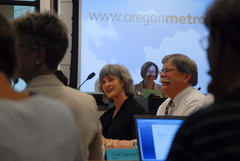
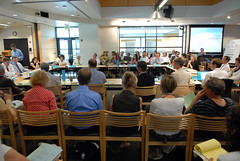

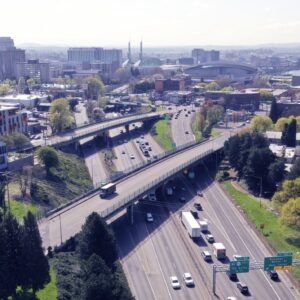
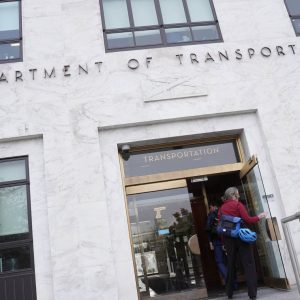
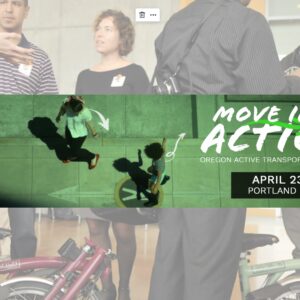
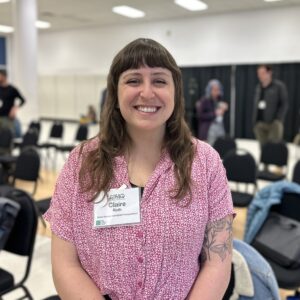
Thanks for reading.
BikePortland has served this community with independent community journalism since 2005. We rely on subscriptions from readers like you to survive. Your financial support is vital in keeping this valuable resource alive and well.
Please subscribe today to strengthen and expand our work.
Whew!
How does metro spend active trans money? Do they distribute it to municipalities or do they spend it on their own programs? In other words, will some of this be put towards the bike master plan goals or parallel goals that are good but perhaps different?
What a relief! Thanks Jonathan, Arow, and the BTA for keeping this on everybody’s radar and getting the job done.
Jonathan, thanks for your great coverage on this. Good job everyone who called and wrote to JPACT!
Yay! however we still need more cash for our goals. don’t let up
Allison,
It is really too complicated to describe in a sentence or two, but this current issue is about the Regional Flexible Funds pot of money only. The RFF is intended to provide a funding mechanism for projects or programs that don’t meet the often strict and inflexible requirements for regular transportation funding.
The RFF dollars can be spent on any project or program, whether it is a local Jurisdiction or Metro sponsored one.
The way we have done it in the past is the framework and targets are set (which is what they were working on here, setting targets). Then when the evaluation period rolls around, jurisdictions and agencies submit projects or programs and those submissions are scored against the framework criteria and matched against targets.
Usually the heavy lifting is done by some small workgroups at Metro that include volunteers from all over the place – to score and rank. Then a list which is usually larger than the amount of money is created.
That list goes to the Transportation Policy Alternatives Committee (TPAC), on which I sit as a citizen member, and we debate the merits of projects and vote and narrow down the list to more or less match the funding available.
The list that we create at TPAC is then forwarded to the Joint Policy Advisory Committee on Transportation (JPACT)to actually vote on. JPACT can sometimes just “rubber stamp” the list, or they may modify it and move projects around as they see fit. JPACT is the actual body with elected officials and people from agencies all over the region.
What JPACT approves then goes to the Metro Council for “official” binding votes. Metro almost always will simply just approve what JPACT presents them – although officially the Metro council could change things if they wanted to – but they rarely will as all of the technical details have been well hashed out by that point. Some times though a highly political item might get modified – something like the CRC perhaps – but for the purposes of the Regional Flexible Funds I would imagine no one ever looks twice, it is such a small pot of money.
That is my description – I may be off a tad, but I think I have the process figured out.
In any event, this is a tiny tiny tiny pot of money, that in my opinion should go entirely to non-conventional transportation projects that have no chance to get money elsewhere. Things like trails or bike/ped bridges…
This is a good thing but I can’t help but think we should be WORKING with freight instead of fighting with freight.
I would think that fewer SOV on the road would help both camps. Simply from the standpoint of efficiency/capital expense. Lower maintenance costs, lower congestion, fewer expensive lane expansions, etc. (Not for the “Church of Green” Whatever THAT is.)
Jeff,
You are absolutely right. What these stories are about is not competing with freight in the over-all big picture.
What this is about is the really small pot of money that is the Regional Flexible Funds.
Freight projects are almost always eligible for the big funding streams – normal transportation funds.
The Flexible Funds should be used for projects that can not get any money anywhere else. Most normal funding for transportation comes with lots of strings attached. Things that are just for bike/ped will often not meet any of those requirements. This is why we will see most major bike/ped improvements come in conjunction with large highway or transit projects because the highway and transit projects meet the requirements to get the large pots of money.
You can’t build much freight infrastructure for $20 million, but you could build several of bike/ped freeway crossings or lots of miles of bike/ped trails for that money…
Less cars on the road makes easier going for trucks. If Portland achieves it’s mode split goals trucks will reap plenty of benefits.
The forces of SOV are expert in the strategy of Divide and Conquer. Wre all complicity in this.
John Reinhold #’s 6 and 8 …your explanation helps me understand the situation better…thanks!
Its a sad day when Metro has such screwed up priorities that they put bike paths and sidewalks ahead of what is really necessary and important, especially when we are in a recession that apears to be worsening. I sy jobs first, money forbikes will come when we can afford it.
PS- There is no such thing as “free money”
No need to have freight versus bikes. For $24 million, we could buy at least 24 cargo bikes and everyone goes away happy!
Nice work, Jonathan. I’m grateful for this deep coverage as a reader and as a sort of archivist.
I thought the $500,000 diversion at the end was weird, too.
I agree with justin. I’m sad that our poloticians can’t see and understand the economic benefits of biking and walking. By walking to work a save money, making it easier for me to live and depend on less.
Looks like Jack Burkman followed through with his commitment to help get federal dollars for active transportation projects.
For those anti-Vancouver people, notice that both Vancouver and Clark County’s representatives voted in favor of the motion.
Greshman no vote is not surprising. How often do regional active transportation project benefit Gresham? If the regional wants a wider support base for active transportation, projects are going to have to be built in areas outside of downtown PDX.
i guess we know where jason tell stands. will he also oppose local control of speed limits?
Active transportation initiatives support the local economy by making it easier for people to NOT use an automobile.
In an infographic on http://www.visualeconomics.com a pretty pie chart shows that the average US household spends 17.6% of their annual income on transportation related costs. From these Department of Labor stats they show an average annual expenditure of $8,758.
What could $8,758 do for the local economy?
By freeing up the money we’ve been led to believe we “have to” spend on automobiles for other expenditures we directly inject capital in to our local economy.
People that have gone carfree have noted that they simply have more to spend by driving less or not at all.
Fewer SOV on the road means lower road maintenance costs, less crowded roads, less pollution, fewer auto crashes, more time for police to respond to actual crime and an easier time all around for freight interests.
Surely multi-ton freight vehicles will be on our roads for a long time. Even if you could hire enough cargo bike drivers to ferry all freight from the local rail yard to it’s final destination the shear man-hours involved would drive the total cost on those goods out of the reach of most.
Attacking active transportation as a waste of money shows the “profit now” mentality that has gotten our country to where it is today.
Investing in active transportation is an investment in infrastructure that benefits freight greatly but in an indirect manner.
This is still a reduction in funding for active transportation. Could it have been worse? Sure, but I don’t think the fact that is wasn’t warrants rejoicing. This is a small setback that could have been major.
This is a mistake by metro.
During a recesion you need to set priorities according to their importance. Basic necesities first, leisurely things last
It’s time for us to send some serious thank-yous to the seven folks who voted to protect at least 75% of the “pathetically small” amount of funds for healthy transportation choices.
rex.burkholder@oregonmetro.gov
kathryn.harrington@oregonmetro.gov
district1@co.multnomah.or.us (Deborah Kafoury)
nick@portlandoregon.gov
jack.burkman@ci.vancouver.wa.us
Steve Stuart: http://www.co.clark.wa.us/bocc/emailform.asp
Can’t find Neil McFarlane’s contact info.
Elections matter, folks. Craddick will be on the Metro Council come next year… contact her if you disagree with her vote:
shirley@shirleycraddick.com
And while you’re at it, throw some bones or volunteer time towards the critical Bob Stacey race for Metro President:
http://www.bobstacey.com/
The biggest obstacle to moving freight in the peak hours on freeways and arterials is too many SOVs. Remove 2 SOVs from a roadway at 45 mph and the same space could be occupied by a semi-tractor-trailer. Get two commuters who now drive alone to bike to work, and you just made room for freight. Active Transportation projects are a win/win.
Major businesses on Swan Island have supported this stategy for 10 years, freight moves up and down Going Street without delay, while employees at Daimler Trucks NA and adidas continue to score in the Top Ten of the Bicycle Commute Challenge.
Reducing SOVs not only makes room for freight, but it also frees up valuable land in industrial/employment areas like Swan Island for productive use. US Barge now builds ocean going barges in a former parking lot at the Shipyards where employees get transit passes at half price.
We know how to do this. In 1997 measures to reduce SOVs across the Columbia River, while one of the two I-5 spans was undergoing repair, were so successful that there were no delays at all for the entire week.
Some thoughts:
1. Awesome. So glad this came out like it did.
2. Big surprise ODOT wanted what they did. It’s like they’ve become the Oregon Constitution Party, except you sub “highways” and “bicycle infrastructure” for “pro-life” and “same-sex marriage,” respectively.
3. Roy Rogers sounds like a reactionary parrot. Or maybe like Rep. Paul Ryan.
4. Craig Dirksen is way off-message, seeing as his city just hired a full-time bike coordinator and is making a huge push for bike infrastructure.
5. Sad to see Ann Lininger casting a “no” vote. If that was a proxy for Lynn Peterson, I would really like to hear the chair explain her vote.
All in all, many thanks to all those who worked so hard on this plan. Big ups to the Yes votes in there: the Metro councilors, Steve Stuart, Deborah Kafoury…class acts all around.
Great organizing work by the BTA, WPC, CLF and other groups and leaders. Also every person’s calls/emails made a difference in securing needed votes.
My recommendation, put all 75% into one or two active transportation projects (or to leverage more money) that will get something big and exciting built. Don’t spread it around like peanut butter.
Jim,
You are missing the point. Metro is VERY supportive of freight mobility, and job creation.
This debate was about one very small pot of money. One single small funding stream.
We are NOT talking about our transportation policy priorities here, or funding priorities, or anything that large. Freight interests have access to billions of transportation dollars in the regular budgets.
Also, as others have already mentioned: People riding bikes or walking on off-highway trails are not driving cars on the roads. When people get around by foot or bicycle, they free up capacity for freight movement. Look how many bicycles we can get into just a couple auto spots in our on-street bike corrals. Every single item we do to make bicycling or walking more appealing, we benefit the entire system. It is NOT an either/or situation.
Also, people who don’t own cars have just as much right to get to work/school safely and easily as people in cars do. Spending a teeny tiny percentage of our transportation dollars may just open up a job opportunity in a part of town for a car-free person that may not have been there without bike/ped infrastructure.
And finally, Bicycle tourism is a booming industry in Oregon. Every dollar we spend making biking around more appealing, attractive, and accessible – is more money we can make with tourism.
win win win
Ha Ha Ha Ha Ha Ha!
I LOVE THIS!!!
I didn’t even know that this option was on the table.
HUGE THANKS GOES OUT TO:
– Jack Burkman, Vancouver City Council Member
– Kathryn Harrington, Metro Councilor
– Rex Burkholder, Metro Councilor
– Neil McFarlane, TriMet GM
– Steve Stuart, Clark County Commissioner
– Nick Fish, Portland City Commissioner
– Deborah Kafoury, Multnomah County Commissioner
Thanks for the great coverage Jonathan!
Hello all, interesting discussion here.
Regarding the earmark of $500,000 for electric vehicles, I left with the impression that it was for the whole region, not just for Clackamas County. Metro’s Carlotta Collette spoke in favor of the idea, talking about helping local companies and local communities. Given the nature of the discussion, it seems unlikely that those JPACT members, having just fought so hard over money that’s 5 years away, would just blithely give some to one county over all the others– esp Clackamas. Since so many of those electeds are working on EV in their jurisdictions, I thought they all voted yes thinking that the $500,000 would be regional money. Metro??
And while we are on the subject of Clackamas, I thought Comm. Lininger’s vote actually made sense given that it was she who proposed the first counter to the Port’s motion at the last JPACT meeting, essentially advocating for a more fair approach. With all due respect to the bike community, Metro, and Portland wheeling and dealing for a different percentage at the last minute, I had to commend Comm. Lininger for actually continuing the line of reasoning for a regional middle ground. Would Comm. Peterson have voted differently? Maybe, but I give Lininger credit for being a thoughtful moderate with no preconceived agendas at this table…
Jonathan:
You are going to have no problems getting through the Pearly Gates. If The Man delivers, prior to that joyous moment, you will see another – streets without those God Dammed automobiles.
Excellent reporting on this, Jonathan! Glad we squeaked this one out. Big ups to Gerik Kransky for leading the charge on this and making sure it was on our radar.
Re-reading this post nearly 3 1/2 years after it was written I can say that this was one of the most important things we’ve done as advocates.
There are still millions and millions of dollars pouring into our community for new bicycle safety projects, sidewalks, pedestrian crossings, and transit station area improvements.
As we fight over priorities year in and year out, let’s remember how powerful we can be when we come together in common cause.